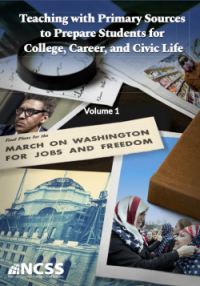Introduction: Teaching with Primary Sources to Prepare Students for College, Career, and Civic Life, Volume 1
Introduction: Teaching with Primary Sources to Prepare Students for College, Career, and Civic Life, Volume 1
If you are reading this introduction, then we are guessing that you are a social studies educator and/or teacher candidate who is interested in finding diverse, authentic, and engaging ways to better prepare your student population for participatory citizenship through the use of primary sources. If so, then this book will be a terrific resource for you. The authors of the chapters in this book are some of the leading thinkers, scholars, and educators in social studies education and routinely utilize primary sources in amazing and dynamic ways in their methods courses, as well as in pre-K–12 classrooms across the country.
This book was developed as part of the Teaching with Primary Sources (TPS) project of the National Council for the Social Studies (NCSS) through a grant generously provided by the Library of Congress. NCSS and the University of Central Florida are proud members of the TPS Consortium, which is comprised of educational organizations nationwide to support high-quality teaching and learning using the vast and free public collections of the Library of Congress. This project was born out of a desire to provide first-class resources for teaching with primary sources through the College, Career, and Civic Life (C3) Framework for Social Studies State Standards.
The C3 Framework was released in 2013 and published by NCSS based on a partnership with hundreds of social studies educators and over a dozen social studies-focused organizations. It has since been adopted or adapted into the social studies standards by a majority of states and, thus, is a significant source of design and implementation of social studies curriculum, instruction, assessment, and professional development for grades K–12. The framework itself is organized by four key dimensions outlining critical elements for authentic and engaging social studies education:
- Dimension 1: Developing Questions and Planning Inquiries. What questions can we consider for social studies inquiry in grades K–6 or grades 6–12?
- Dimension 2: Applying Disciplinary Concepts and Tools. What does interdisciplinary practice look like in order to prepare all students for college, career, and civic life? What is a case study that helps us structure interdisciplinary learning with primary sources?
- Dimension 3: Evaluating Sources and Using Evidence. How do we access and select specific primary sources to answer our inquiry question? What are proven strategies for working with primary sources? What accommodations, scaffolds, and considerations should we consider with primary source use? How do we supplement additional resources with our primary sources?
- Dimension 4: Communicating Conclusions and Taking Informed Action. How do we assess student learning through primary sources and through answers to an inquiry question? What do we do with our “answered questions”? In other words, how we can apply the concept of “informed action” as an action from our inquiry learning?
The C3 Framework and its Inquiry Arc were chosen as the organizational basis for this book, both because NCSS is a proud and active supporter of professional standards and learning built on this Framework and also because the Framework models and supports how primary sources work in all four dimensions of the Inquiry Arc. The authors of the chapters found within this book focused on all four dimensions of the Inquiry Arc found within
the C3 Framework; however, special attention was paid to Dimension 4: Communicating Conclusions and Taking Informed Action as we wanted this resource to help educators think about how to take learning with primary sources beyond the confines of the classroom walls in a variety of ways with real-world application.
As we embarked on this journey of developing a series of books focusing on the C3 Framework, taking informed action, and teaching with primary sources, we wished for and envisioned chapters such as the ones that have come to fruition here. Our hope is that this book can serve as an introduction and resource for teacher candidates and/or educators at all levels who are passionate about social studies education and who want to help their
students better understand how to construct narratives based on available evidence and how their acquired knowledge can inform action. The chapters that follow are from some of the best methods professors and educators who are teaching with primary sources as a means to producing and supporting active and engaged citizens.
Lastly, we want to personally thank you for your effort and time in reading this book and for having the desire to provide opportunities for authentic inquiry in your own classroom. One of the most powerful gifts and lessons that you can provide your students is to help them to learn and understand authentic and effective ways of understanding the past and the world in which they live. From this, these empowered individuals can take the knowledge gained in your classroom out into their own communities to take informed action to better the world in which they learn, work, and live.
Scott M. Waring, Ph.D.
Professor and Program Coordinator of Social Science Education
University of Central Florida
Lawrence M. Paska, Ph.D., CAE
Executive Director
National Council for the Social Studies

